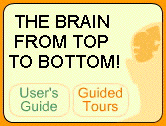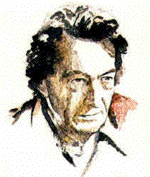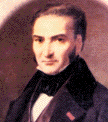La présence éventuelle d'une publicité ci-dessus est insérée par le routeur du mailing-liste indépendamment de mes choix en compensation de la gratuité de son service Dr O Walusinski baillement.com baillement.info yawning.info 

mardi 1er juin 2004 la lettre d'information du site baillement.com N°30 Si vous ne voyez pas les images, cliquez ici pour lire cette lettre dans votre navigateur. If you cannot see pictures below, to view the email in your web browser click here baillement.com est libre d'accès, base documentaire pour comprendre, chercher, travailler
PVNNoyau paraventriculaire de l'hypothalamus Chef d'orchestre du bâillement 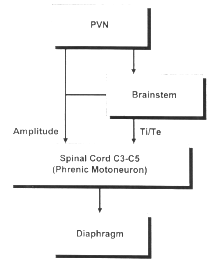
- The paraventricular nucleus contains two types of cells :
- -parvocellular: medially, secrete hypothalamic releasing hormones such CRH; dorsally and ventrically, neurons project to the medulla ans spinal cor to exert autonomic control. Some of this neurons secrete oxytocin and vasopressin, which act as neuromodulators and are able to trigger yawning and penile erection.
- -magnocellular: two distinct populations control endocrine function by secreting oxytocin and vasopressin directly into the posterior pituitary.
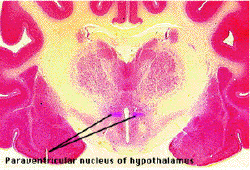
How does behavior influence the brain? - Although this question is explored less often than its converse, understanding the mechanisms through which behavioral encounters can modify neural structures may reveal general patterns of social influence on physiology. The reproductive axis is a primary locus for this influence, typically suppression of reproductive maturation or competence of an individual by the presence of dominant conspecifics
Brain and sexual behavior K Larsson S Ahlenius Annals of the New York Academy of Sciences 1999; 877; 292-308 - G. Serra et A. Argiolas écrivaient en 1967
- L'injection d'ACTH dans le liquide céphalorachidien ou directement dans le cerveau a pour effet d'induire un syndrome caractérisé par des étirements et des bâillements répétés fréquemment. L'ACTH synthétique a été injectée dans différentes aires du liquide céphalorachidien et du cerveau à travers des canules laissées à demeure. Les résultats de ces expériences ont démontré que les aires entourant le troisième ventricule sont les plus sensibles à l'action neurotrope de l'ACTH. Chaque mouvement d'étirement est accompagné d'un réveil "behavioral" et EEG. L'injection d'ACTH dans ces aires produit aussi une excitation sexuelle.
Yawning : the role of the paraventricular nucleus- The paraventricular nucleus (PVN), a cell group located bilaterally along the third ventricle, regulates neuroendocrine and cardiovascular functions, and modulates sympathetic outflow. The PVN is the hypothalamic center that adapts and coordinates hormonal and autonomic responses to the appropriate behavior. With respect to day/night rhythms in physiology, it is clear that the PVN is crucial for transmitting and integrating hormonal and autonomic information, resulting in an adequate regulation of peripheral organs.
- Recurrent episodes of yawning and penile erection can be induced in experimental animals either by intracerebroventricular (i.c.v.) injection of adrenocorticotropin (ACTH) and derived peptides, or by the injection of nanogram amounts of oxytocin in the PVN, or by the systemic administration of dopamine (DA) agonists such as apomorphine.
- While the importance of penile erection in reproduction does not need to be further stressed, it is pertinent to recall that yawning is considered to be a mechanism of arousal. The results, that are presented, have shown that the paraventricular nucleus of the hypothalamus (PVN) is an essential brain area for the regulation of these behaviors.

Bâillements : le rôle du noyau paraventriculaire de l'hypothalamus - Le noyau paraventricullaire de l'hypothalamus (PVN), bordant de chaque côté le III° ventricule, régule les fonctions neuro-endocrines et cardio-vasculaires. Il module les influx neurovégétatifs en particulier sympathique. Sous l'influence des alternances rythmées jour/nuit, le PVN est crucial pour transmettre et intégrer les informations hormonales et autonomiques résultant d'une régulation adéquate des organes périphériques.
- Des épisodes répétés de bâillements et d'érections péniennes peuvent être induits, de façon expérimentale chez l'animal, soit en injectant de l'hormone ACTH en intra-ventriculaire ou divers neuropeptides dont l'ocytocine (qq nanogrammes) dans le PVN, ou par injection systémique d'agonistes dopaminergiques (apomorphine).
- L'érection pénienne est un élément clé de l'acte reproducteur qui, représentant un moment de risque élevé vis à vis des prédateurs, doit intervenir en état d'éveil maximal. Les travaux présentés ici montre le rôle fondamental joué par le PVN dans l'élaboration de ces comportements.

- Behavioral effects induced by intracisternally injected ACTH and MSH Ferrari W, Gessa GL Ann NY Acad Sci 1963; 104; 330
- Hypophysectomy prevents yawning and penile erection but not hypomotility induced by apomorphine Serra G, Gessa GL Pharmacol Biochem Behav 1983; 19; 917-919
- Paraventricular nucleus lesion prevents yawning and penile erection induced by apomorphine and oxytocin but not by ACTH in rats Argiolas A; Gessa GL Brain Research 1987; 421; 349-352
- Hypophysectomy prevents ACTH-induced yawning and penile erection in rats Serra G et al Pharmacol Biochem Behav 1987; 26; 277-279
- Effects of septal and hippocampal stimuli on paraventricular nucleus neurons D Saphier, S Feldman Neuroscience1987; 20; 3; 749-755
- Evidence that apomorphine induces penile erection and yawning by releasing oxytocin in the central nervous system Melis MR, A Argiolas, GL Gessa Eur J Pharmacol 1989; 164; 565-570
- Role of calcium in the expression of ACTH-induced stretching, yawning and penile erection A Argiolas et al Brain Research Bulletin1990; 24; 853-856
- Oxytocin-induced penile erection and yawning: role of calcium and prostaglandins Argiolas A, Melis MR Pharmacol Biochem Behav 1990; 35; 3; 601-605
- Periaqueductal gray lesions do not affect grooming, induced electrically in the hypothalamic paraventricular area in the rat AM Van Erp et al Behavioural Brain Research1993; 59; 95-101
- PVH lesions do not inhibit stressor-induced grooming in rat AM. Von Erp, MR. Kruk, et al Physiol Behav 1995; 57; 5; 887-892
- Neuronal substrate of electrically induced grooming in the PVH of the rat: involvement of oxytocinergic systems? AM. Von Erp, MR. Kruk, et al Physiol Behav 1995; 57; 5; 881-885
- Dopamine agonists increase nitric oxide production in the paraventricular nucleus of the hypothalamus: correlation with penile erection and yawning Melis MR, S Succu, et al Eur J Neurosci 1996; 8; 10;, 2056-2063
- Dopamine agonists increase nitric oxide production in the paraventricular nucleus of the hypothalamus: correlation with penile erection and yawning MR Melis et al Eur J Neurosci 1996; 8; 2056-2063
- Cardiorespiratory components of defense reaction elicited from paraventricular nucleus Y Duan Physiology &Behavior 1997; 61; 2; 325-330
- The paraventricular nucleus of the hypothalamus influences respiratory timing and activity in the rat E Yeh Neuroscience letters 1997; 232; 63-66
- Yawning role of hypothalamic paraventricular nitric oxide Melis MR, Argiolas A Acta Pharmacol Sinica 1999; 20; 9; 778-788 (abstract)
- Activation of gamma-aminobutyric acid(A) receptors in the paraventricular nucleus of the hypothalamus reduces apomorphine-, N-methyl-D-aspartic acid- and oxytocin-induced penile erection and yawning in male rats Melis MR, Spano MS, Succu S, Argiolas A Neurosci Lett 2000; 28; 1; 2-3; 127-130
- Hypothalamic integration of central and peripheral clocks Buijs RM; Kalsbeek A Nature R Neurosci 2001; 2; 521- 525
- Reduction of drug-induced yawning and penile erection and of noncontact erections in male rats by the activation of GABAA receptors in the paraventricular nucleus: involvement of nitric oxide Melis MR , A.Argiolas Eur J Neurosci 2002; 15; 5; 852-60
- Suprachiasmatic nuclei grafts restore the circadian rhythm in the paraventricular nucleus of the hypothalamus Tousson E, Meissl H J Neurosci. 2004; 24; 12; 2983-2988

Yawning circumstances How is a yawn triggered? Neurophysiology of yawning The curious phenomenon of contagious yawning Yawning ? Francis Schiller (1909-2003) Journal of the History of the Neurosciences 2002; 11; 4; 392-401 Why do people yawn ? Simonds AK Student BMJ 1998; 6; 191 Yawning J Barbizet J Neurol Neurosurg Psychiat 1958; 21; 203-209 Yawning Aloe F Arq Neuropsiquiatr 1994; 52; 2; 27-36 Yawning: an evolutionary perspective Smith EO Human Evolution 1999; 14; 3, 191-198 version en français pdf
Yawning : its cycles, its rolesO. Walusinski, BL. Deputte - Halfway between a reflex and an expressive movement, yawning is a very commonplace phenomenon. Despite that, remarkably little interest has been paid to it in research and medical practice. Organisms from reptiles or birds to human, from the womb to the death were found to be displaying it.
- Yawning is a phylogenetically old, stereotyped event that occurs alone or associated with stretching and or penile erection in humans and all mammals. For many years, all the theory proposed from the day of Hippocrates until the middle of the XXth century have been debunked.
- Embryology show that yawning gives evidence of the perfect neurological development of the brain stem. Neurophysiology explains its cerebral mechanisms. Through the relativity brief history of psychopharmacology, concepts of relationship between the actions of psychotropic drugs and the functions of specific brain systems have particularily progressed.
- Yawning appears as an example of stereotyped behavior which have permitted the development of new researches about many neurotransmitters. In human and other mammals, a strong social induction of this behavior can be observed when it is exhibited within a social group. Ethology advance new concepts. On the one hand,with the apparent communicatory role of yawning, the question arises whether yawns can be produced volontarily or on the other hand, why the sex differences in the frequency of yawning (males yawn much more than females) disappears by humans. In several sexual or agonistic contexts, non-human primates or rats yawn. This behavior pattern characterized by his apparent irrelevance to the situation is interpreted as a displacement activitie. Why did humans lose this capacity and trigger an other, the contagiousness of yawning ? It's seems a part of a more general phenomenon known as mental state attribution.
- The recent discovery of the neuron's mirror system by G. Rizzolati and the capacity of the functional imagery to prove the activation of the sulcus temporalis superior provide a new insight of this intricate behavior.
- On the basis of knowledge flowing from phylogenesis to embryology, ethology, neurophysiology, this article integrates meaningfully datas and unifies a substantial amount of disparate researchs. Such an opportunity to review the explanatory findings about yawning was never published before.

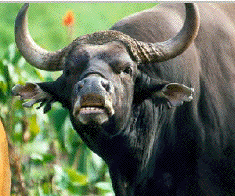
Sniff yawning in bovinae U. Von Halder, R. Schenkel Z Säugertierkunde 1972; 37; 232-245
Das Riech-Gähnen bei Rindern (Bovinae)Von Ulrich Halder und Rudolph Schenkel Z Säugertierkunde 1972; 37; 232-245 - Sniff-yawing occurs in most species of Bovinae. Most often it occurs in the context of special maternal activities, e. g. licking of amnion fluid and placenta after parturition and licking of the offspring. (See place of oxytocin in the neurobiology of attachment)
- Sometimes flehmen and sniff-yawning occur in succession, sometimes vicariously. These facts as well as basic similarities in appearence suggest that sniff-yawning, similar to Flehmen, is in its function a special chemoreceptory process. Although investigations still lack extensiveness, it is tentatively suggested that in sniff-yawning as in Flehmen Jacobsons Organ (Organon vomeronasale jacobsoni) is set in action. Sniff-yawning would appear as the predominantly female-maternal variation of receptory activity involving Jacobsons Organ, while Flehmen would have to be considered as the more spezialized male variation. Despite the similarity between, on one side, yawning in the context of resting or activation behaviour, on the other side sniff-yawning, these behaviours are markedly different from a functional point of view, while sniff-yawning and Flehmen seem more closely related.
- Based on these considerations the following phylogenetic relationship is suggested:
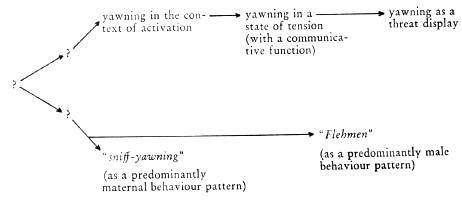
- Le comportement de bâillement-flairage existe chez la plupart des bovidés. Le plus souvent, il apparaît au cours de certaines situations particulières de la reproduction, comme, par exemple, le lèchage du liquide amniotique et du placenta après la mise-bas et le lèchage du veau nouveau-né. (Voir la place de l'ocytocine dans la neurobiologie des liens d'attachement mère-enfant)
- Ce comportement ressemble à celui appelé 'Flehmen behavior', dont la fonction est d'améliorer la perception, par l'organe voméro-nasal, de certaines phérormones. Il semble qu'on puisse considérer que le bâillement-lèchage est plus particulièrement une attitude femelle liée à la mise-bas tandis que le 'flehmen' est plus spécifquement mâle et lié à la reconnaisance de la periode de fécondité des femmelles. En tous cas il est clair que le bâillement d'éveil et de repos est bien différent du bâillement-lèchage qui lui est proche du 'flehmen'.
Extracephalic yawning painJacome D Cephalalgia 2004; 24; 5; 411-413 Compulsive yawning as migraine premonitory symptom Jacome D Cephalalgia 2001; 21; 5; 623-5 Primary yawning headache Jacome D Cephalalgia 2001; 21; 6; 697-699
-
The aim of this study was to report on two patients with recurrent, paroxysmal, extracephalic pain triggered by yawning. Pain with yawning may occur in several conditions (secondary yawning pain) or develop in the absence of precipitating lesions (primary yawning pain). Primary yawning pain is normally of cephalic location. Methods used were clinical neurological examinations, magnetic resonance imaging of the brain, computerized head tomography, electroencephalogram, blink reflex studies and Panorex X-ray views of the skull. The first patient had intense right shoulder pain and brief apnea for 2 years triggered by yawning. The second patient had yawning pain referred to an area of the neck where a thyroid tumour (Hurthle cell carcinoma) was later found. Neither of the two patients could precipitate their pain with imitation of yawning and neither had evidence of Eagle syndrome. Only the second patient had a history of migraine. Yawning pain may have an extratrigeminal and extracephalic distribution. It rarely serves to identify a lesion underlying the area where the pain is perceived. - Ce travail de D. Jacome décrit deux observations de douleurs provoquées par les bâillements. Le premier patient ressentait une vive douleur du bras accompagnée d'une apnée lors de chaque bâillement. La deuxième patiente ressentait une douleur de la partie antérieure du cou à chaque bâillement. Alors qu'aucune exploration n'a pas permis de trouver de cause dans le premier cas, un diagnostic de cancer thyroïdien a pu être porté pour le second cas. Dans aucune de ces deux pathologies, l'imitation du bâillement ne déclenchait le phénomène douloureux. L'ampliation maximale du pharynx (*4) lors du vrai bâillement ( et non de son imitation) peut expliquer une compression mécanique de la tumeur thyroïdienne.
-
"Le cerveau à tous les niveaux " est un superbe site, mais aussi un outil pédagogique pour répondre aux questions que tout un chacun se pose sur le cerveau. - La visite s'effectue un peu comme dans un musée à travers lequel un guide va orienter le parcours suivant l'intérêt et surtout le niveau de connaissance de son groupe. Une visite est indispensable.
- Le contenu du site "Le Cerveau à tous les Niveaux" est sous copyleft. Différentes méthodes vous permettent donc de reproduire ce site en tout ou en partie pour en faire bénéficier le plus grand nombre. Le concept de " copyleft " est un moyen de donner accès gratuitement au fruit d'un travail original et d'encourager la reproduction (et même la modification) de ce travail d'une façon tout aussi gratuite. (dans l'esprit de baillement.com)
- Il s'agit donc d'une démarche radicalement à l'opposé du " copyright " traditionnel qui semble de nos jours vouloir s'étendre à absolument tout (gènes, propriété intellectuelle, etc.). D'inspiration libertaire, le concept de copyleft valorise la liberté d'expression et s'oppose surtout à l'idée que la connaissance puisse être la propriété privée de quelques élus.
- D'ailleurs, ce n'est sans doute pas un hasard si le développement du copyleft est intimement lié à celui d'Internet (grâce aux logiciel " open source ", comme Linux par exemple). L'idéal des premiers internautes a toujours été la démocratisation de l'information qui, grâce au Net, pouvait enfin échapper au contrôle de haut en bas des médias commerciaux. Mais vendeurs et publicitaires ont envahi le Net au point de nous faire oublier la vocation première des sites web personnels : partager nos passions avec autrui.
- Comme Le Cerveau à tous les Niveaux ! a été conçu dans un esprit de diffusion des connaissances, c'est sans hésiter qu'il a fait sienne la philosophie du copyleft. Non seulement pouvez-vous donc reproduire ce site en tout ou en partie sur tous les supports que vous pouvez imaginer, mais vous êtes même encouragés à le faire ! Une seule restriction cependant, toujours dans l'esprit du copyleft : apposer la griffe " copyleft " sur les variations inspirées de ce travail pour qu'elles conservent leur totale accessibilité au plus grand nombre.
- Cela dit, comme il s'agit d'un site sur des connaissances scientifiques, une certaine rigueur est de mise pour conserver la validité des faits. Mais se servir par exemple d'une partie de son contenu dans le cadre d'un cours de biologie ou d'un de ses schémas pour un autre site web sur le comportement humain est tout à fait approprié.
- "The brain from top to bottom" is a beautiful website, but also a didactic tool that answers to many questions that anyone asks about the brain. A visit is necessary.
- The content of the site "The Brain from Top to Bottom" is under copyleft. The concept of "copyleft" is a method of providing free access to the results of original work and of encouraging people to reproduce and even modify this work on an equally free basis. (as the spirit of yawning.info)
- Copyleft is thus diametrically opposed to the traditional concept of copyright, which nowadays people seem to be trying to use to cover absolutely everything, from genes to intellectual property. In the libertarian spirit, the concept of copyleft promotes freedom of expression and staunchly opposes the idea that knowledge can be the private property of a small elite.
- It is also probably no accident that the development of copyleft has been intimately associated with that of the Internet, thanks to open source software such as Linux. The ideal of the earliest explorers of the Internet was always the democratization of information which, thanks to the Net, would at last escape the top-down control of the commercial media. But nowadays, people with something to sell or advertise have invaded the Net to such an extent that we have forgotten the primary purpose of personal Web sites: to share our passions with other people.
- The Brain from Top to Bottom was designed in precisely this spirit of sharing knowledge, and so has not hesitated to embrace the philosophy of copyleft. Not only are you allowed to reproduce this site in whole or in part on any medium you can imagine, but you are even encouraged to do so! Just one restriction, however, still in the spirit of copyleft: always make sure to include the copyleft symbol on all variants based on this Web site, so that they too will remain totally accessible to as many people as possible.
- That said, since this is a site about scientific knowledge, you should still exercise a certain degree of rigour to make sure that the facts you present are still accurate. But if you want, for example, to use part of this site's content in a biology course, or reproduce one of its illustrations on another Web site about human behaviour, both of these uses are entirely appropriate.
Signes tirés du bâillementSignes tirés des pandiculations François Joseph Double 1776 - 1842 Séméiologie générale, ou traité des signes et de leur valeur dans les maladies Trois tomes parus de 1811 à 1822 (Orthographe respectée) - « Des considérations rapides sur le mécanisme du bâillement, laissent facilement entrevoir le degré d'influence qu'il doit avoir sur l'économie. Quelle idée ne prendra-t-on pas de son importance, si l'on réfléchit à l'état général de l'économie qui le précède et qui le termine, et par exemple à l'espèce de stupeur et d'engourdissement qui le prépare, au sentiment de lassitude et de faiblesse qui le devance, et au contraire à la sensation agréable qui le suit, au délassement et au bien-être qu'il procure. C'est dans la méditation ce ces divers objets, que l'on retrouve l'indication de la plupart des signes que l'expérience a attaché au bâillement ».
- [………]
- « Les bâillemens fréquens, suivis de larmoyement et de pandiculations, sont les signes précurseurs des fièvres éruptives..............J'ai observé très souvent les bâillemens avec sternutation, aux approches des fièvres catarrhales que nous voyons régner si fréquemment d'une manière épidémique dans la capitale ».
- [………]
- « En général, le bâillement
est un signe mortel toutes les fois qu'il existe un grand
épuisement des forces dans les maladies
aigües; par exemple, chez les femmes qui sont en
travail d'enfantement, et même durant les maladies
aiguës des femmes en couches ».
Remerciements au Dr Michel Suspène (Verdun sur Garonne) auteur de la biographie : Le docteur François-Joseph Double, un itinéraire médical.
Télécharger un texte retraçant les connaissances historiques sur le bâillement pdf ( Dr O. Walusinski )
The yawn heardround the world Scott Thomas Illustrations by Tatjana Mai-Wyss 30pages - 2003 Tricycles press Berkeley, California

This is an original 1933 Coca-Cola advertisement featuring a Lady Yawning while playing a game of cards. «Don't trump your partner's ace, refresh yourself and be alert...snap back to normal»
-
Autres documents mis en ligne ce mois-ci :
- Extracephalic yawning pain Jacome D
- Mouvements involontaires dans les membres paralysés Pierre Marie et André Léri 1911
- Elemens de pathologie générale AF Chomel 1824
- Fracture of an ossified stylohyoïd bone J Mc Ginnis
- Calcified stylohyoid ligament:unusual pressure symptoms Fanibunda K
- Clinical TMD, pain related disability and psychological status of TMD patients Yap A, Cha E, Hoe K
- Integrated jaw and neck function in man. Studies of mandibular and head-neck movements during jaw opening-closing tasks Zafar H
- Behavioral effects induced by intracisternally injected ACTH and MSH Ferrari W, Gessa GL
- Boredom and the yawn L Bell
- Delayed cerebellar disease and death after accidental exposure to dimethylmercury Nierenberg DW et al
- Sigismond Jaccoud biographie
- Clinical neurologic assessment tool: development and testing of an instrument to index neurologic status Crosby L
- Etude sur les pandiculations automatique des hémiplégiques M Bertolotti 1905
- Traité de pathologie générale Monneret 1857
- Séméiotique ou Traité des signes des maladies AJ Landre-Beauvais 1815
- Role of calcium in the expression of ACTH-induced stretching, yawning and penile erection A Argiolas et al
- Involvement of beta-adrenoceptors in regulation of the yawning induced by neuropeptides, oxytocin and a-Melanocyte-Stimulating Fujikawa M, K Yamada
- Oxytocin-induced penile erection and yawning: role of calcium and prostaglandins Argiolas A, Melis MR
Résultats du sondageau 31 mai 2004 Une recherche sur le site ?
-
Nombre de questionnaires remplis : 1255 - Combien de fois bâillez-vous par jour ? <5 = 25,8%.. 5-10 = 26%.. 10-15 = 15.5%.. 15-20 = 8.6%.. >20 = 24,1%
- Ressentez-vous des baillements excessifs ?
- 72,7% = non, tant mieux
- 26,1% = oui et je ne sais pas pouquoi
- 6,8% = oui et je prends des antidépresseurs
- 1,3% = oui et je prends des anti-épileptiques
- 4,7% = oui et je prends d'autres médicaments
- 2,6% = oui et j 'ai des troubles neurologiques
- 2,5% = oui et j 'ai des troubles hormonaux
- 3% = oui et j 'ai des tics moteurs
- 1,9% = oui et j 'ai des tocs
- déclenchez-vous facilement le bâillement d'autrui ? 75,5%
- êtes-vous sensible au bâillement d'autrui ? 73,8%
- "Comment espérer qu'un
jour l'Homme, que nous portons tous en nous, puisse se
dégager de l'animal que nous portons
également si jamais on ne lui dit comment
fonctionne cette admirable mécanique que
représente son système nerveux? Comment
espérer voir disparaître
l'agressivité destructrice, la haine, la violence
et la guerre? N'est-il pas indispensable de lui montrer
combien aux yeux de la science peuvent paraître
mesquins et ridicules les sentiments qu'on lui a appris
à considérer souvent comme les plus nobles
sans lui dire que c'est seulement parce qu'ils sont les
plus utiles à la conservation des groupes et des
classes sociales, alors que l'imagination
créatrice, propriété fondamentale et
caractéristique de son cerveau, n'est le plus
souvent, c'est le moins qu'on puisse dire, absolument pas
exigée pour faire un honnête homme et un bon
citoyen."
Henri Laborit (1914-1995), L'agressivité détournée, p 8
baillement.com baillement.info yawning.info écrits et réalisés par le Dr Walusinski
Voici le nombre d'abonnés à cette lettre : courriel à adresser lire les lettres précédentes d'information du site

